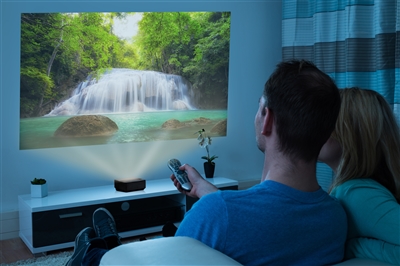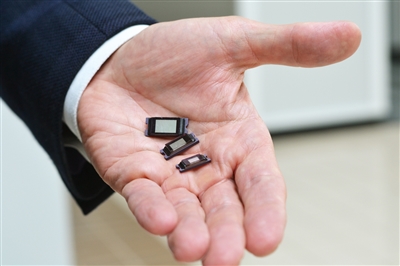SSZTBC8 May 2016
Think about all the times and places your customers could use a big screen TV experience. But for some reason or another – aesthetics, portability, display quality – it’s not an option.
Until now. What was once impossible is rapidly becoming a reality with the development of mobile smart TVs, also called screenless TVs.

From bedrooms to boardrooms, to backyards and beyond, these compact devices combine advanced projection displays with wireless connectivity to deliver an experience that is truly on the go.
Today’s mobile smart TVs wield the latest in advanced optics, bright and durable light-emitting diode (LED) illumination sources, and efficient TI DLP® Pico™ chips to create an accurate, high quality image on a variety of surfaces.

So, What Is Mobile Smart TV?
Imagine transforming any surface into a theater by simply placing a small electronic box on a table and having it project upward. Paired with a wireless connection, a user can easily pull in content from the Internet for viewing. Or using a smartphone, they could send pictures to the mobile smart TV and project it virtually anywhere.
Using our energy-efficient DLP Pico chips as the foundation, mobile smart TV can deliver big, compelling images in non-traditional environments like walls, fences, the side of your home or even on the ceiling. Basically, given the right lighting conditions, mobile smart TV works where other display technologies might not.
A key area driving today’s mobile smart TVs is shorter throw ratio, which means users can project a larger image from a shorter distance than traditional projectors. Placing a mobile smart TV just a few feet away from the display surface, such as a wall, results in easily achieved high-definition images as large as your typical flat panel. And yes, users can adjust the size of the image to suit their needs.
LED illumination is another development setting the stage for mobile smart TV growth. Rather than using bulbs, mobile smart TV makers use LEDs as an illumination source because of their large color gamut, smaller size, high brightness, greater energy efficiency and comparatively longer life span. Right now we’re also seeing some use of lasers as an illumination source, but it remains early in that process.
The State of Mobile Smart TV
Right now, I consider mobile smart TV to be in the pregame show – there is a lot more to come in my opinion. Some of the key needs and trends in this space are very small form factor products that are battery powered and don’t even look like a projector but can almost magically make an image appear anywhere.
Innovators of mobile smart TV products include JmGO, LG, Philips, and xGimi. JmGO is the maker of the innovative P1, an all-in-one device with a compact cylindrical form factor (245mm x 73mm) for easy transport. It projects big images, yet weighs 1 kilogram and can operate for several hours on internal battery. LG’s PF1000U is an ultra-short throw LED home theater projector capable of displaying big picture video in full high-definition (HD). The device uses Android OS software to wirelessly stream content through apps and was honored with a 2016 CES Innovation Award. The Screeneo Smart LED Projector HDP1690/F7 from Philips is another example of a unique projector featuring ultra-short throw capability, integrated speakers, and a subwoofer. In addition, xGimi recently released the H1 which features full high-definition (HD) display with a built-in Harman Kardon audio system.
The DLP Technology Advantage
It’s no accident that DLP technology is a key component in this new wave of mobile smart TVs. Compared to other solutions, a DLP chip paired with LED illumination offers impressive power efficiency in terms of lumens per watt, contrast ratio and video reproduction.

Because of access to an extensive ecosystem of design partners, DLP Products’ integration of optical engines makes it easier and simpler for systems integrators to incorporate into their upcoming mobile smart TV products. It also frees them up to focus on more compelling, differentiated product features instead of having to work on the projection aspect of their product.
As the drive toward smaller, faster and brighter solutions continues, I believe the future of mobile smart TV is very bright indeed. Read our latest mobile smart TV white paper for more technical details about this exciting new technology.